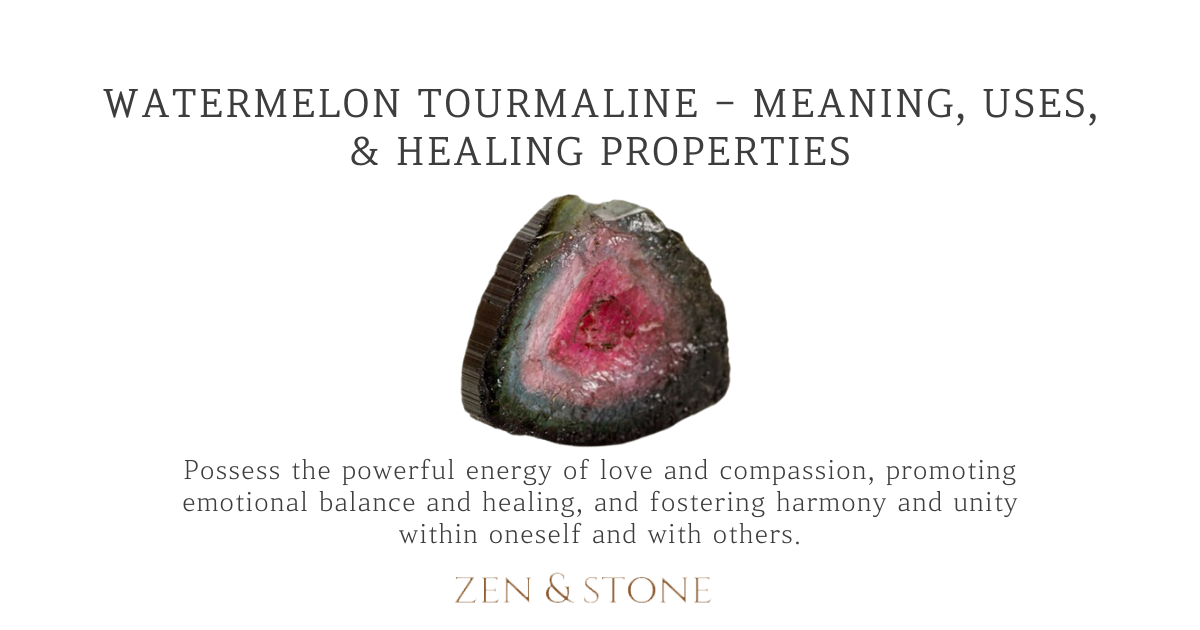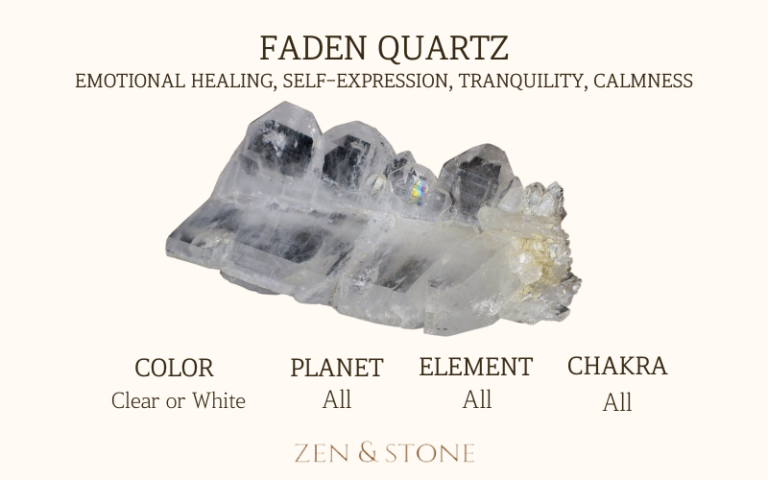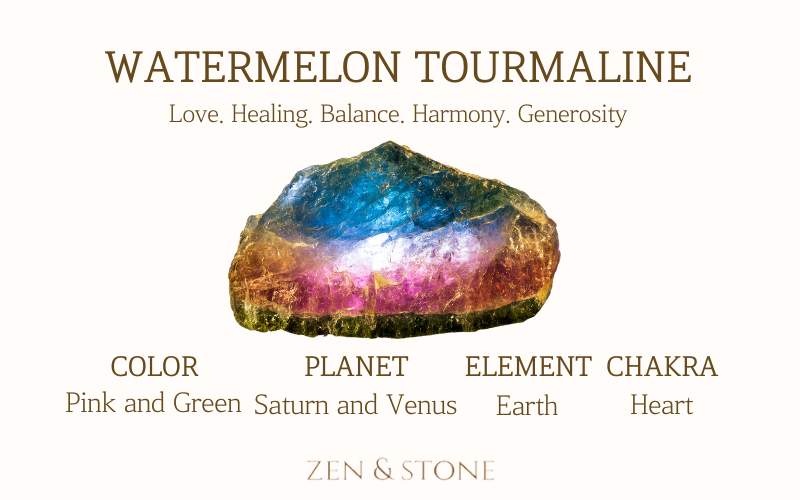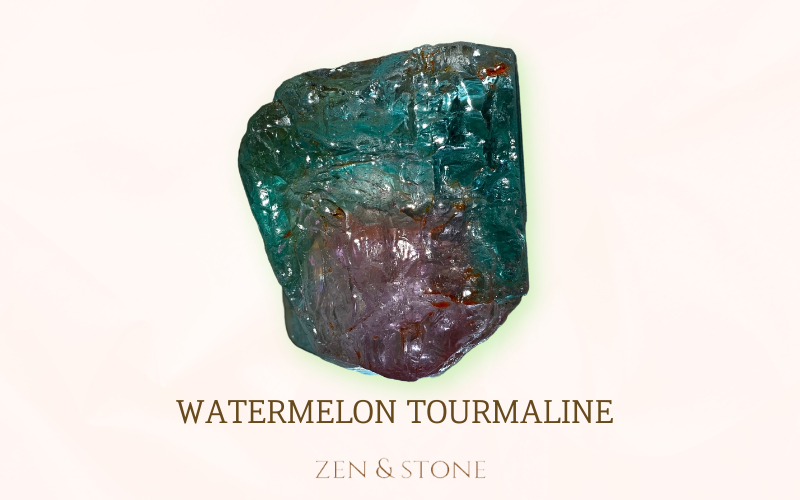
20 Feb Watermelon Tourmaline – Meaning, Uses, & Healing Properties
Watermelon Tourmaline, renowned for its vibrant hues reminiscent of the fruit it’s named after, exudes a captivating allure that effortlessly uplifts spirits. Its unique blend of pink and green hues creates a delightful aesthetic reminiscent of summertime sweetness. As a cherished addition to any crystal collection, Watermelon Tourmaline infuses spaces with a playful energy, evoking feelings of joy and vitality.
Let’s look at the meaning of this enchanting Watermelon Tourmaline.
What Is Watermelon Tourmaline?
Watermelon Tourmaline is a unique variety of Tourmaline, a crystalline silicate mineral group in which boron comprises elements such as aluminum, iron, magnesium, sodium, lithium, or potassium. It occurs commonly in various colors. Hence its etymology; “stone of mixed color,” and this stunning combination is rare and collectible. Watermelon Tourmaline features a reddish-pink center and green exterior, reminiscent of a watermelon rind. They also display pleochroism, which means that their color changes when they’re viewed from different angles.
Moreover, these stones are formed in areas where volcanoes have produced magma, which has cooled with large empty cracks that naturally fill with water and minerals such as iron, lithium, or magnesium. Watermelon Tourmaline is found in Brazil, Nigeria, Madagascar, Afghanistan, and the United States.
History Of Watermelon Tourmaline Stones
Tourmaline was first discovered in the late 1600s-early 1700s by Dutch traders off the West Coast of Italy. According to ancient legend, it is found in every color because it came to the Earth along a rainbow, collecting all its hues.
Miners discovered Watermelon Tourmaline in Maine, USA, in 1902, and it has since been designated as the state gemstone. Although it doesn’t have much history, it has been highly prized by collectors and crystal enthusiasts for its stunning color combination and metaphysical properties.
Mineralogy
Indeed, people value Watermelon Tourmaline’s unique and beautiful appearance, featuring a distinctive combination of pink and green colors. It is a variety of Tourmaline, a complex mineral that can exhibit various colors depending on its chemical composition.
On the other hand, Watermelon tourmaline is particularly popular due to its vibrant colors, high transparency, and unique crystal formations. In this discussion, we will explore the mineralogy, formation, geographic locations, dynamic healing properties, and other aspects of watermelon tourmaline.
Watermelon Tourmaline Healing Properties

Let’s take a look at the great benefits of using this Watermelon Tourmaline Crystal.
Spiritual Healing Properties
For spiritual properties, Watermelon Tourmaline emits positive energy, making it a beneficial stone to have. Watermelon Tourmaline helps to cleanse negative energy, remove blockages, attract positivity, and shield against bad vibes. It’s also a great stone to enhance the experience of connecting with nature, the elements, and animals.
Emotional Healing Properties
Watermelon Tourmaline Crystal has emotional healing properties. This crystal can also soothe the mind, balance moods, heal the heart chakra, enhance self-love and confidence, and inspire creativity. It is often used in meditation, energy healing, and other spiritual practices for emotional healing and well-being.
Mental Healing Properties
Also, Watermelon Tourmaline is highly recommended for anyone struggling with body confidence issues due to beauty standards, eating disorders, body dysmorphia, weight issues, disfigurements, and injuries.
Furthermore, it instructs us in diplomacy and tact, enabling us to integrate logical thinking with emotional sensitivity. It helps us to see the lesson in everything. It increases our capacity to love and instills a sense of joy, optimism, emotional safety, and security.
Physical Healing Properties
Watermelon Tourmaline motivates us to value our bodies as precious, encouraging healthier habits and self-care. This benefits the physical heart and nervous system, aiding conditions like multiple sclerosis or paralysis.
Feng Shui Element
Because of its pink and green hues, Feng Shui practitioners connect watermelon tourmaline with the Earth, Water, and Wood elements. It is often placed in the Wealth and Prosperity corner of the home or office to enhance the flow of abundance and prosperity. The gemstone can also be set in the Heart or Root chakra areas to promote emotional healing and balance or in the center of the home or office to promote overall balance and harmony.
Where Does It Come From?
Watermelon Tourmaline is a variety of Tourmaline, a boron silicate mineral that occurs in many different colors. It is found in various locations around the world, including Brazil, Madagascar, Namibia, Nigeria, Mozambique, and the United States (California and Maine). However, the most significant sources of watermelon tourmaline are Brazil and Mozambique.
Mining and Treatments
It is typically mined through traditional methods and may undergo various treatments to enhance its color or clarity. Apart from this, the most common treatments are heat treatment, irradiation, and diffusion. Note that, it’s essential to inquire about any treatments the crystal may have undergone when purchasing to ensure you get a genuine product.
Formation and Crystal Associates
Watermelon Tourmaline is formed in pegmatite rock formations. It is often associated with other minerals, including quartz, feldspar, mica, and different types of Tourmaline. Its distinctive pink and green coloration is due to the manganese and iron within the crystal lattice. It has a hexagonal crystal structure with a hardness of 7 – 7.5 on the Mohs scale.
Why are some Tourmalines multicolored?
Tourmalines can be multicolored due to the complex chemical composition of the crystal. Tourmaline crystals contain several elements, including aluminum, boron, silicon, and various metals like iron, manganese, and lithium.
The specific combination of these elements and their concentration within the crystal lattice can result in a wide range of colors, including pink, green, blue, yellow, and black. Besides, different concentrations of impurities or changes in crystal growth can create areas of varying color within the same crystal, resulting in bi-color or tri-color tourmalines.
For example, watermelon tourmaline exhibits pink and green coloration due to manganese and iron within the crystal lattice.
Physical Characteristics
Watermelon Tourmaline is a durable and scratch-resistant gemstone that typically forms in long, skinny crystals with a rounded triangular shape. It has a shiny appearance and can be pink and green in color due to certain elements being present within the crystal.
Geographic Locations
It is in several locations worldwide, including Brazil, Nigeria, Afghanistan, Mozambique, and the United States. These crystals are known for their vibrant colors and high transparency, with each location having unique characteristics. Other countries where watermelon tourmaline can be found include Madagascar, Namibia, Tanzania, and Zambia.
Zodiac Associated
Although it’s not an official birthstone, Moonstone resonates well with the energies of extraverted Libra, dual Gemini, and structured Virgo as it helps to lighten them up and open them up to deeper connections.
Planets Associated
Similarly, green Tourmaline is sometimes associated with the planet Venus, which is associated with love, harmony, and creativity. However, the associations between gemstones and planets can vary depending on tradition or spiritual practice.
Element
Watermelon Tourmaline Crystal is associated with the Earth element as it is a mineral that forms in the Earth’s crust. The Earth element represents stability, grounding, and material abundance, which are qualities that can be attributed to the properties of Watermelon Tourmaline Crystal.
Watermelon Tourmaline Chakras
The heart chakra, also called the Anahata, is the fourth chakra in the energy system. Heart Chakra is located in the chest area of the body. It allows us to love, empathize, nurture, heal, and forgive ourselves and others.
This is also connected to our feminine energy, heart health, and the health of the surrounding areas. Moreover, it can become blocked from heartbreak and betrayal, which results in issues trusting and empathizing with others, as well as negative self-talk and difficulty letting go of the past.
Physically, blockages can affect the heart and lungs, resulting in heart palpitations, chest pains, breathing difficulties, issues with blood pressure, and poor circulation.

What Does It Look Like?

Watermelon tourmaline has a unique and distinctive appearance characterized by its pink and green coloration. The gemstone typically has a light to medium pink center surrounded by a thin green outer layer, resembling a watermelon’s cross-section. The colors can vary in intensity, with some stones exhibiting a more vibrant pink or green hue.
In contrast, others may have a softer, more pastel-like coloration. The gemstone can be transparent to translucent, with a vitreous to resinous luster. Watermelon tourmaline can exhibit many crystal formations, including prismatic, columnar, pyramidal, and radial aggregates.
The crystal formations can affect the overall appearance and desirability of the gemstone, and some collectors may prefer certain formations over others.
Usage and Cleansing
How to Use Watermelon Tourmaline
Here is how you can use these gemstones in your everyday life.
Meditation
Use Watermelon Tourmaline during meditation if you want to open your heart, cleanse and protect your energy, remove blockages from your mind or system, and improve your self-image.
Manifestation
Watermelon Tourmaline is also used to manifest money, love, friendship, and other personal goals, such as career opportunities, by holding it or keeping it close when practicing your manifestation techniques.
Watermelon Tourmaline At Home Or Work
If you want to utilize Watermelon Tourmaline’s healing powers in your home or workplace, keep it somewhere important or centric in your home or workplace, such as by the front door or in your office room.
Crystal-infused Water & Crystal Baths
Infuse your Watermelon Tourmaline stone with water by leaving it in water overnight to drink or spray around your home to absorb its goodness straight into your body or release it around you and spruce up the atmosphere. Alternatively, take a crystal bath by wearing or putting your gem in the tub to soak in its goodness.
Cleansing & Charging Your Gemstone
It’s a good idea to cleanse and also charge your Watermelon Tourmaline crystal every few weeks to rid it of negative or dark energy and refill it with positive energy for healing.
The easiest way to cleanse crystals is with the full moon’s light. You can do this by placing it outside or on your window sill on the night of the next full moon. Try putting it in a water bowl first for an intense intuitive cleanse.
Alternatively, you can run it under the tap, smudge it with sage, or place your gem on a crystal-cleansing plate. To charge it, leave it in the sun for a few hours or place it on or under the Earth for 24 hours.
Frequently Asked Questions
What pairs with watermelon tourmaline?
Watermelon tourmaline can be paired with gemstones like rose quartz, amethyst, citrine, clear quartz, and blue topaz to enhance its healing properties and create beautiful jewelry pieces.
Alternative crystal for Watermelon Tourmaline
If Watermelon Tourmaline isn’t right for you, alternative crystals that vibrate on a similar level include Rose Quartz, Rhodonite, Emerald, and Green Adventurine.
Gemstones that complement its energy include Selenite, Amethyst, Lapis Lazuli, Labradorite, Carnelian, Sunstone, Clear Quartz, and other Tourmaline stones, such as Black Tourmaline, Red Tourmaline, and Blue Tourmaline.
Is watermelon tourmaline rare?
Although Tourmaline is a common mineral mined worldwide, Watermelon Tourmaline is a rare and collectible variation highly prized by crystal lovers.
Conclusion
Watermelon Tourmaline is a gem for lovers of rare crystals and heart chakra stones. With its gorgeous hot pink core and pretty green outer layer, it’s full of love and bright, juicy energy. If you’re lucky enough to get your hands on a piece, follow our top tips for the best results, and beware of fakes!

Sorry, the comment form is closed at this time.